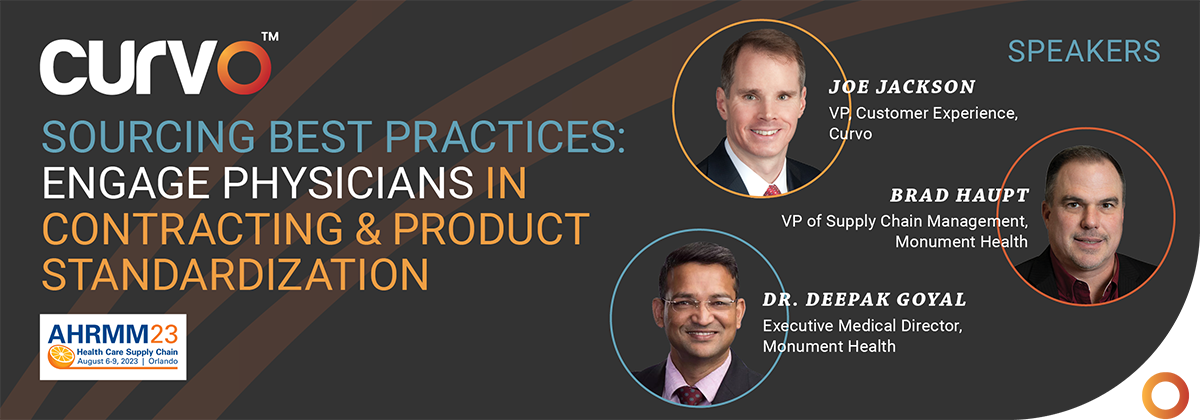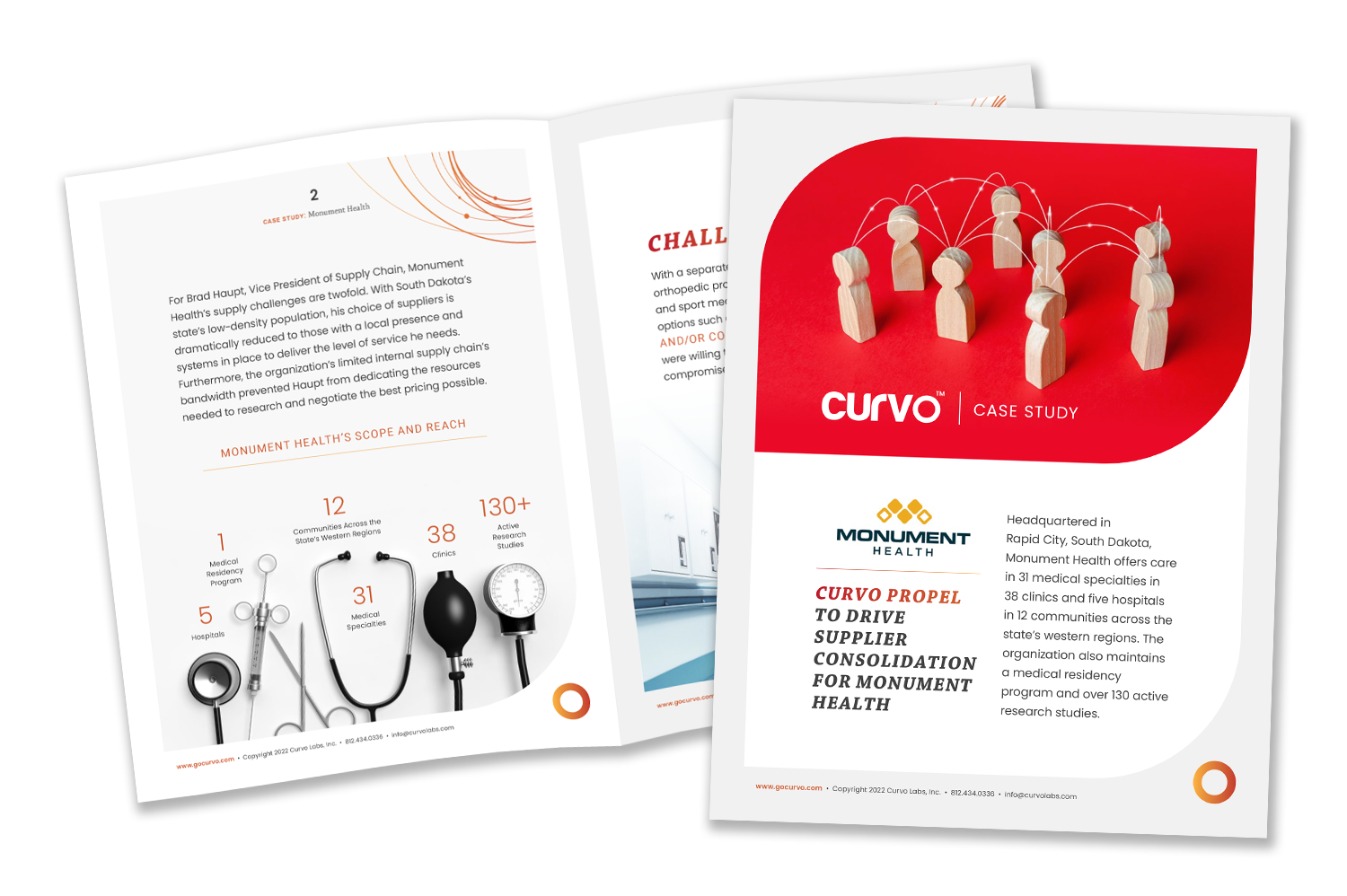Home Blog PPI Sourcing Strategies to Reduce Clinical Variation

AHRMM23 Session Highlights:
PPI Sourcing Strategies to Reduce Clinical Variation
Leadership & Strategy Strategic Sourcing
Couldn’t make it to Orlando for AHRMM23? Or maybe you did attend and caught this informative session, but you wish you’d taken better notes.
No worries. This blog captures highlights of the popular AHRMM23 presentation: Sourcing Best Practices: Engage Physicians in Contracting and Product Standardization. Over 110 people gathered to hear these supply chain experts:
- Dr. Deepak Goyal - Executive Medical Director, Monument Health
- Brad Haupt - Vice President of Supply Chain Management, Monument Health
- Joe Jackson - Vice President of Customer Experience, Curvo
Takeaways from AHRMM23 Sourcing Best Practices Session
Strategic contracting and product standardization help hospitals manage suppliers efficiently, while accruing savings and reducing clinical variations. Session attendees were eager to learn more about successful techniques to reduce expensive clinical variations. Here are some session highlights.
Monument Health Mission: Find Value by Controlling Costs
“Even large medical systems like Monument Health are struggling, yet the United States healthcare spend is over $4 trillion dollars – more than the GDP of India,” said Dr. Goyal. “This is the money we spend to provide healthcare, but life expectancy is probably among the lowest among all developed countries.
“Where’s the value?” That's the question. What we’re missing in healthcare today is value. Cost of care is so high that we’re reducing value. How is it acceptable? And do we have a role to play in this?”
The authors and presenters of this session work from the premise that if they contain the cost of healthcare, they might achieve more value. Monument Health aims to control rising healthcare costs in order to provide better value to patients and support hospitals' ability to care for those unable to pay.
Changing Perceptions Through Closer Collaboration
Clinicians must be part of the medical device contract process, although it’s not a common practice yet. In fact, only a few hands went up when session attendees were asked how many have physicians directly involved in product contracting and standardization. Some organizations might think involving clinicians makes sense for product selection, but contracting?
“In some hospitals, there’s a perception that physicians always present a barrier. The supply chain would sign a contract, and no one would be compliant with it. Many times the hospital would lose out on rebates,” said Haupt. “That's what the struggle has been, and we are very well positioned to tackle this.
“My thought was, let's get the physicians involved on the front end,” explained Haupt. “Rather than waiting until we're ready to see prices or sign an agreement, let's meet with physicians who are going to use the product. Let's get their thoughts and take in their knowledge of the industry.”
Reach Physicians Early On for Buy-In
The presenters noted that now when they go for a big contract such as in cardiology, orthopedics, or a new surgery space, they look at how to achieve good physician buy-in early on. The session told the story of how Goyal and Haupt successfully engage physicians by gathering with medical staff and attending section meetings.
“Instead of thinking that physicians are going to throw a wrench into the works, we need to understand where they come from and the difference in training. They have industry knowledge, and they have some existing relationships. Once we engaged physicians, I found them very helpful,” said Dr. Goyal.
Presenters noted the need to provide stakeholders with good data and trusted education on compliance and rebates. Curvo worked closely with Monument Health, providing enriched clinical data, along with other strategic sourcing solutions and services.
Safe Place to Discuss Common Concerns and Resources
“We’ve both made ourselves available to our clinicians. They can reach out to us, and we try to provide resolution as soon as possible. It’s a low cost means of dispute resolution and for building responsibility for governing common resources,” Dr. Goyal explained.
“This has been a historic moment for us. Monument Health has provided ‘psychological safety’, not only for the supply chain, but also for physicians that it's okay to talk about this. If they have any concern, it's okay to just bring it up to leadership and vice versa,” said Haupt.
“Physicians have this feeling of ownership. It's also ‘psychological safety’ for our manufacturing and supplier partners that we have a three-way dialogue. It's a free flow of communication.”
Trust Is Payoff of Good Relationships with Suppliers
“Monument Health has such great relationships with suppliers, which is really important,” declared Joe Jackson. “I think it's noteworthy that any time I speak to Monument suppliers, they love working with the organization. They like transparency. They like the speed. They like understanding that Supply Chain and the physicians are aligned. It gives them a lot of comfort.
“The supplier relationship with Monument is different from other organizations, where it's a bit more antagonistic, and the trust isn't quite there, but I don't get any of that with the Monument suppliers,” he added. “I think it's a direct byproduct of all the work they have been doing on creating physician alignment and trust.”
Contract Methodology Includes Physician Input
Working with Curvo, the Monument Health team created a methodology for big, upcoming PPI contracts:
- Send RFP invitations to suppliers.
- Involve physicians. Let them know contract is coming and take insights to section meetings.
- Get physicians to vote based on data analysis with multiple data points.
“The providers basically make the call, and everyone is held accountable for following that contract,” said Haupt.
New Sourcing Methodology Finds Value in Cardiology Project
Because of this approach, Monument Health achieved good value in the cardiology space, where they had been looking at large CRM contracts. A three-year agreement was ending, and they needed to do another.
Before even starting the RFP, the supply chain had a strategic meeting with physicians. “We needed to learn what the physicians really wanted out of our contracts and collaborate to get the most financial benefit, as well as have the best products available for quality outcomes,” explained Brad Haupt.
Meeting with those physicians, the supply chain team learned that some suppliers had new products soon to be approved by the FDA. Those devices would be revolutionary to the CRM space, and doctors wanted access to the technology when it became available within the next three years.
“We designed our RFP to get to the point where we could get the most benefit from our existing long-term partner, but also have access to a new supplier with new technology,” explained Brad Haupt. “The contract actually got approved sooner than we thought it, and the physicians are already using it.”
With Physician Alignment, CRM Sourcing Project Took Just 22 Days
The collaboration generated a nice savings, but equally noteworthy was the speed made possible by tight physician alignment. “We completed that project in 22 days from the initial RFP to the contract signature, and that's pretty darn impressive,” declared Brad Haupt.
What can health systems do at a fundamental level to engage physicians? Here are tips shared during the Monument Health AHRMM23 session:
- Apply utilization and cost data to create confident physician engagement.
- Use metrics to raise physician awareness that quality of care and product savings aren’t mutually exclusive.
- Use enriched financial data including tier and outcome scenarios to make meaningful decisions.
Reduce Clinical Variations with These Recommendations
Getting inspired to step up your own strategic sourcing and reduce costly clinical variations? Session recommendations include:
- Have good understanding of annual spend by working with experienced spend management partner.
- Engage physician leadership and have a defined process in place.
- Expose physicians to need for at least a basic understanding of contracts and what compliance requires.
- Focus on reducing clinical variation, eventually working back to preference cards.
- Enlist external guidance to focus on best opportunities.
The presenters also recommended healthcare supply chains “enlist some sort of external guidance to at least identify which battlefield to go and fight on. We cannot pick a fight at each and every place.”
Strategic Sourcing for Financially Sustainable Healthcare
“This has opened a whole new world of possibilities for us,” said Brad Haupt. “We found that we might have an opportunity between six to $800,000 or more, just by reducing our clinical variation.”
“This goes to fundamentally something we all have in our organizational mission vision and values. We have to be financially sustainable. Our mission is to be here for generations to come,” noted Dr. Goyal.
“If we're able to control this cost of healthcare, we can introduce value for our patients. Hospitals and health care systems can actually have more dollars to care for indigent patients and we as a community, would be all successful,” Dr. Goyal added.

